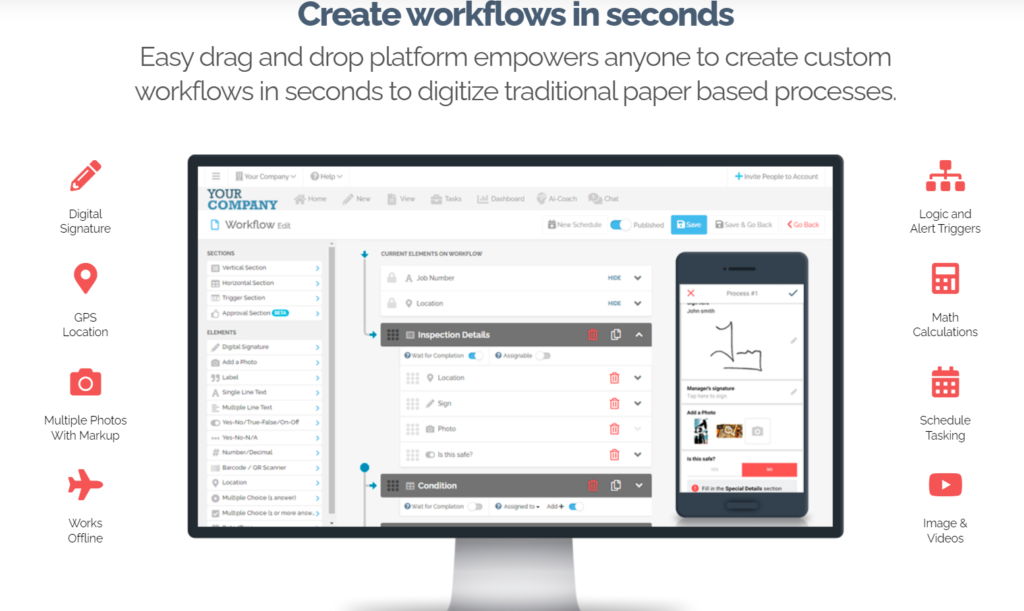As the world of manufacturing continues to evolve, so too do the methods used to ensure optimal performance and longevity of machinery. One such method that has gained significant traction in recent years is predictive maintenance. This approach, powered by data and technology, aims to prevent costly breakdowns by accurately predicting when maintenance needs to be completed. But like any other method, it comes with its own set of advantages and disadvantages. In this article, we will delve into these pros and cons, and how a digital workflow procedure builder like FAT FINGER can help you navigate them.
Before we dive in, we invite you to request a demo to see how FAT FINGER can empower your front-line teams to do their work correctly every time, unlocking operational excellence in the process.
Advantages of Predictive Maintenance
There are several compelling reasons why many manufacturers are turning to predictive maintenance. Here are some of the key benefits:
- Cost Savings: Predictive maintenance can help identify potential issues before they escalate into costly repairs or replacements. This proactive approach can result in significant cost savings over time.
- Improved Efficiency: By accurately predicting when maintenance is needed, downtime can be minimized, leading to improved efficiency and productivity.
- Enhanced Safety: Predictive maintenance can also contribute to a safer working environment by identifying potential safety hazards before they become a problem.
- Extended Equipment Lifespan: Regular, timely maintenance can extend the lifespan of machinery, providing a better return on investment.
Disadvantages of Predictive Maintenance
Despite its many advantages, predictive maintenance is not without its drawbacks. Here are some potential challenges to consider:
- High Initial Costs: Implementing a predictive maintenance program can be expensive, particularly for small and medium-sized businesses. This includes the cost of sensors, software, and training.
- Complex Implementation: Predictive maintenance requires a certain level of technical expertise to implement and manage. This can be a barrier for companies without a dedicated IT team.
- Data Overload: Predictive maintenance generates a large amount of data, which can be overwhelming and difficult to manage without the right tools and expertise.
How FAT FINGER Can Help

Despite these challenges, the benefits of predictive maintenance can far outweigh the disadvantages, especially when you have the right tools at your disposal. This is where FAT FINGER comes in.
FAT FINGER is a digital workflow procedure builder that empowers front-line teams to do their work correctly every time. With features like a drag & drop workflow builder, mobile & desktop workflows, dashboards, integrations, augmented reality, IoT device connectivity, and artificial intelligence coaching, FAT FINGER allows you to build predictive maintenance digital workflows that ensure problems are gone even before they start.
By leveraging FAT FINGER’s capabilities, you can effectively manage the data generated by predictive maintenance, streamline the implementation process, and ultimately, maximize the return on your investment.
Conclusion
Predictive maintenance is a powerful tool that can significantly improve the efficiency and longevity of your machinery. While it does come with its own set of challenges, these can be effectively managed with the right tools and expertise. FAT FINGER’s digital workflow procedure builder is designed to help you navigate these challenges, empowering your teams to do their work correctly every time and unlocking operational excellence in the process.
Ready to see how FAT FINGER can transform your predictive maintenance strategy? Create a predictive maintenance workflow for free or schedule a demo today.
Discover the pros and cons of predictive maintenance and how it can impact your business operations. Weigh the advantages and disadvantages to make an informed decision. Don’t miss out on this opportunity to optimize your maintenance strategy. Schedule a Demo today to learn more.


